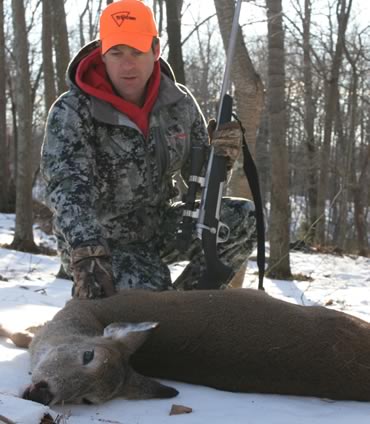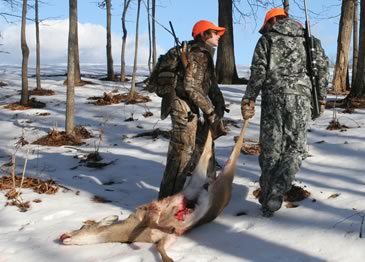Is there a formula for the perfect whitetail herd?
As the deer project leader for the Virginia Department of Game and Inland Fisheries, Matt Knox is often face-to-face with some of the most respected whitetail experts in the country. Knox and his fellow biologists love to discuss deer management, and when the term balance comes up, Knox is quick to challenge his peers.
“I ask them what the definition of a balanced herd is, specifically what a balanced age structure looks like,” he says. “No one can give me a straight answer.”
The word balance gets tossed around among deer hunters and deer biologists. Everyone wants a balanced deer herd, but, as Knox acknowledges, no one seems to know exactly what that is.
HOW MANY BUCKS AND DOES?
In a perfect setting, a buck-to-doe ratio of one-to-one is the ideal scenario. After all, an equal number of bucks and does are born each year, so it seems obvious there would be an equal number of males and females in an unhunted population. Surprisingly, that’s not the case.
Texas A&M-Kingsville research scientist Dr. Charles DeYoung says the buck-to-doe ratio on a large unhunted research facility in South Texas is closer to one buck for every 1.5 does. Knox recalls a fellow biologist who works with unhunted urban populations that have typical ratios of about one buck to two does. DeYoung says no matter how protected the population is, there will always be fewer males than females.
“Bucks lead a much more stressful life and are more prone to natural mortality and accidental death,” he said. “They travel farther and therefore encounter more risky situations like fences and roads, and they get into some pretty violent fights and can sustain serious injuries. In some cases, those injuries are fatal.”
So does that mean wildlife managers should strive to mimic that unhunted balance of 1.5 or two does per buck? Not necessarily, says biologist and Quality Deer Management Association executive director Brian Murphy. Even if the so-called perfect and unhunted balance is somewhere in the neighborhood of 1.5 or two does for every buck, that doesn’t mean those numbers need to be duplicated everywhere. Murphy says the human definition of balance is equally, or even more, important. Biologists manage deer mostly through hunting to maintain population levels that satisfy hunters and non-hunters.
Even with high buck mortality through hunting, buck-to-doe ratios are rarely as skewed as many hunters think they are. Talk to any veteran Pennsylvania deer hunter, and he’ll recall days of watching 50 or more does parade past his stand before he saw the first buck. South Carolina DNR biologist Charles Ruth says hunters are missing the point when they make those observations.
“If you are talking about antlered deer and antlerless deer, they can be way out of whack,” he said. “But it’s very rare for the male-to-female ratio to be much lower than one-to-three, even where buck harvest is high.”
That’s because in areas with high fawn recruitment, there will always be a high number of button bucks, which we see as antlerless deer. Ruth says where recruitment rates are high — typical throughout much of the South, Southeast and Midwest — it’s mathematically impossible to go much below the 1:3 ratio because does have an average of 1.5 fawns each. For every 100 does, for example, there are 150 fawns. Seventy-five of those fawns will be bucks. Even if you somehow removed all the bucks after breeding season, there would still be a one-to-three ratio of males to females the following spring.
 AGE MATTERS
AGE MATTERS
The real concern, Ruth and Murphy agree, is the age balance, particularly among bucks. But even that is open to debate. That aspect of deer management is borne largely from the evolving desires of recreational hunters. Murphy says at least 20 states have some form of buck restriction. Most, if not all, are driven by hunter desires. The best way to cater to those desires is to manage for a balanced age structure.
“Hunters these days want older bucks. By limiting the harvest of younger bucks, we can give hunters what they want while providing a more diverse age structure,” says Murphy.
At one time, biologists were more interested in providing ample numbers of legal deer, usually bucks, through restricted antlerless harvest and limited buck harvest. In those days, hunters just wanted to harvest a legal deer. In many cases, that resulted in a skewed age structure with lots of yearlings and few mature bucks. Prior to instituting antler point restrictions, about 85 percent of the annual harvest in Pennsylvania was yearling bucks. Clearly, the age structure was out of balance.
Today, more emphasis is being placed on producing older and larger bucks. As a result, wildlife managers are placing emphasis on more diverse and balanced age structures. Knox, however, is still waiting for one of his colleagues to make a strong case for the right age structure in a deer population.
“Biologically speaking, there really isn’t a specific reason we need a certain number of bucks of a certain age. It’s pretty much all hunter driven, which is fine,” he says. “There may be a loss of genetic diversity if the does are getting bred only by 1½-year-old deer, but even that would take thousands of years to notice.”
Contrary to the concern by some biologists and hunters, there is no evidence that a high number of young bucks has altered breeding cycles or has had any other negative biological implications. Knox says studies have proven that no matter what the age structure, the does get bred and they get bred on time to ensure the survival of the species.
Other studies have shown that breeding is far more random than biologists originally thought. It was widely accepted that older bucks did most of the breeding, but that’s not the case.
“I suppose a balanced buck herd would be one-third 1-year-olds, one-third 2-year-olds and one-third 3-year-old or older bucks, but who’s to say that’s right?” Knox asks. “I think biologists can agree that an 85-percent yearling ratio is unbalanced, but what about some herds in South Texas where 40 percent of the bucks are 4½ or older? Is that balanced, or is that skewed in the opposite direction?”
 THE HABITAT BALANCE
THE HABITAT BALANCE
What matters most in the balance equation, Knox and Murphy agree, is how deer affect the landscape. Biologically, the habitat doesn’t change if it’s being eaten by a buck or doe, a yearling buck or a five-year-old buck. It does, however, suffer if there are too many deer.
“We should strive for the number that hunters desire while maintaining a herd that doesn’t do damage to the habitat. However, the health of the habitat needs to be considered first,” says Murphy. “I would say balance is best defined as staying at or below the carrying capacity of the habitat, although even that might be considered a shaky definition.”
Pennsylvania is a prime example of what can happen when deer exceed the carrying capacity of the habitat. The Pennsylvania Game Commission says the entire makeup of the forest has been permanently altered as a result of too many deer and too little available food. As a result, they drastically changed their deer program and increased the doe harvest and decreased the antlered buck harvest starting in 2002.
Biologists can gauge deer impact by examining the plant diversity and the effect of deer browse on plant growth. In the most extreme cases, the forest understory will be gone, leaving nothing but mature trees and no ground-level plants. Or there will be a distinct browse line at the maximum reach of deer.
You can debate whether other environmental factors like acid rain and poor forestry practices are as much to blame for lack of regeneration, but deer are clearly the easiest to manage in the short term.
An even better gauge of herd balance is the physical characteristics of the deer themselves. By using historical data, biologists can examine body weights for various age classes, antler beam diameter, recruitment rates and even lactation rates to determine if the herd is in balance with the habitat.
Murphy says to strike a balance with the landscape, deer numbers would have to be lower than most hunters would consider acceptable. He said whitetails provide some benefit to the habitat through browsing, but they do more harm than good in higher numbers.
“Ideally, a lower number of deer is better for the habitat, but it’s unlikely numbers will get low enough to provide the maximum benefit to the overall health of the forest while meeting the desires of most hunters,” he said.
Murphy says the real definition of balance, whether it centers on habitat, age structure or sex ratio, is a constantly evolving term. What might be a balanced herd today might not fit the definition in a decade. In the meantime, Knox waits patiently for someone to tell him exactly what it means to have a balanced deer herd.
Read Recent Articles:
• When the Food Is Gone: Can you help deer through harsh winters without doing more harm than good?
• The Myth of Knockdown Power: Dropping a deer in its tracks is about shot placement, not bullet energy.
• Passing It On: The ins and outs of introducing youngsters to deer hunting.
This article was published in the September 2011 edition of Buckmasters Whitetail Magazine. Subscribe today to have Buckmasters delivered to your home.